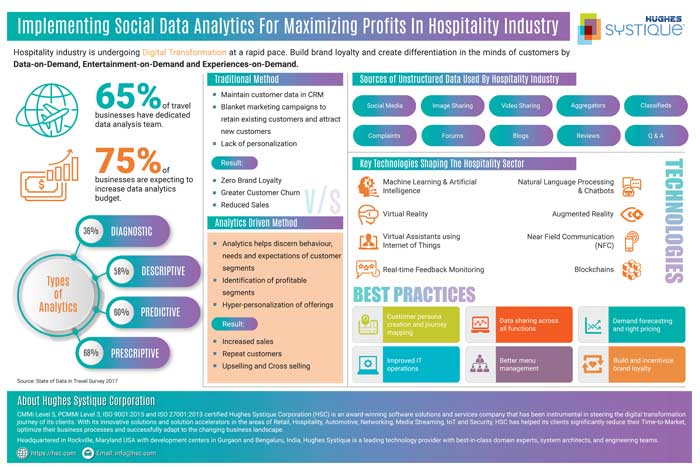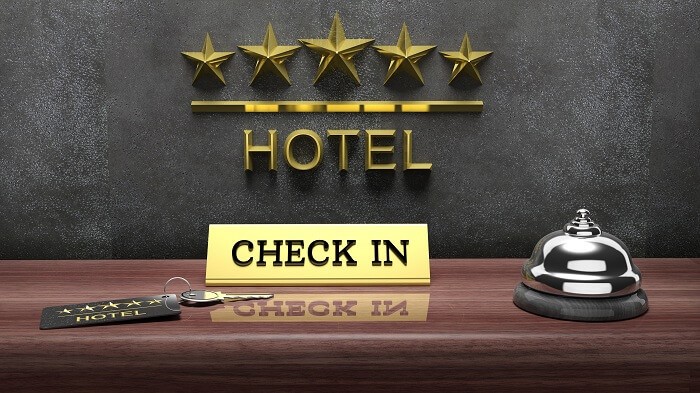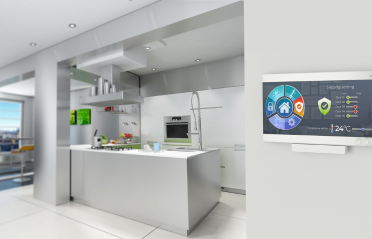When Ray, an experienced sales person and a globe trotter, checked into Marriot Hotel in Dubai last month, he was left pleasantly delighted. He had been put up in his favorite room with a personalized welcome message and there was an extra pillow in his bed as well. Ray remembered having called the room service during his last stay about 7 months ago when he had asked for an extra pillow. Touched by the service, he immediately logged into TripAdvisor using the Hotel Wi-Fi (which was also free for him) to give the hotel a 5 Star rating and a favorable review.
This impeccable service from Marriot will surely leave its mark on Ray who may prefer Marriot over the others in his subsequent visits.
Leading names in the hospitality industry are gradually adopting this practice to meaningfully accumulate unstructured Social Data. This data includes signals from social media channels, blogs, forums, image sharing sites, video sharing sites, aggregators, classifieds, complaints, Q&A, reviews etc. The data is then mined to analyze meaningful patterns which can translate to customer experience management through different approaches on business decisions, marketing, customer service, reputation management, sales etc.
Traditional Method of Targeting in Hospitality Industry:
Most hotels dutifully maintain their customer data in their CRM and have some kind of in-house or third party loyalty programs. They use blanket campaigns using the same messaging and same offer for all of their customers. The marketing campaigns to acquire new customers also follow the same method. These hotels fail to create brand loyalty in guests who yearn for personalized services & experiences. So they don’t think twice before switching to competitor brands whenever they get a good offer from them.
Analytics Driven Customer Segmentation and Profiling:
Social data analytics helps Hoteliers to get a clear understanding of segment behavior, needs, and expectations. It helps them identify profitable customer segments, their buying preferences: personalized methods can be devised to target the profitable segments. Right Positioning for these segments helps to encourage repeated visits, increase sales during their stay by upselling profitable services like fine dining, exotic wines & cocktails, gyms, spa services, golf theatre, local site trips etc.
Best Practices to be followed to maximize profit:
- Customer Persona Creation and Journey Mapping: Through in-depth analysis of guest demographics, psychographic and lifestyle characteristics; attributes such as income levels, family status, age, sports and cultural interests, spending patterns, can be attributed to model guests. Bespoke marketing messages can be designed accordingly. Within a particular income group, some guests might love spending on fine dining, whereas some of them are only interested in Gyms or sight-seeing or religious activities. Therefore, targeting them with the same email or the same special offers is not a good idea. Instead, by developing unique programs for them, there is a greater probability of winning their mind share and heart share.
- Data Sharing: The customer data should not only be used by the Marketing team, but also shared across the departments like Restaurant, Revenue Management Team and even Housekeeping also. When the Restaurant gets the customer data beforehand, they may think about offering super personalized menu for the most profitable segments. For example, there may be greater customer satisfaction if the restaurant offers to serve the customer’s favorite cocktail or the lobster dish even before she orders the same. The housekeeping can use the data for decorating the room with customer’s favorite flowers and room freshener according to the customer’s choice and providing an extra pillow (like in the example above) or putting a personalized greeting card. These small gestures are well appreciated by the customers whose frequency of visits and spending at these hotels increase. Even some of the elated customers may go a step forward by acting as brand ambassadors in their personal circles and social media sites.
- Demand Forecasting and Right Pricing: Forecasting is one of the biggest strength of Data Mining and the hotels can use forecasting properly to perfectly price their inventory. Improved revenue management algorithms should take into account seasonal data, the data from hotel booking and hotel review websites together to create optimal pricing for the inventory. Lean season discount offers can be rolled out to price-conscious segments whereas to the profitable segments, bundled offers like a romantic dinner, free use of Spa or Gym can be given.
- Improved IT operations: As a corollary to the above point, proper demand forecasting can further help in determining maximum and minimum seasonal loads. Based on this data the IT team can estimate the server capacity and fine-tuning can be done accordingly.
- Better Menu Management: Social data can help streamline the menu management process. During off-season, a simplified and standardized menu can be designed to keep down the cost of ingredients and minimize wastage. During peak times, it helps in demand forecasting and making popular items to be available with minimum waiting times. Hotels can also experiment with carrying out of popular items and delis.


 Product Engineering Services Customized software development services for diverse domains
Product Engineering Services Customized software development services for diverse domains
 Sustenance Engineering Going beyond maintenance to prolong life of mature products
Sustenance Engineering Going beyond maintenance to prolong life of mature products
 Managed Services Achieve scalability, operational efficiency and business continuity
Managed Services Achieve scalability, operational efficiency and business continuity
 Technology Consulting & Architecture Leverage the extensive knowledge of our Domain Experts
Technology Consulting & Architecture Leverage the extensive knowledge of our Domain Experts



























